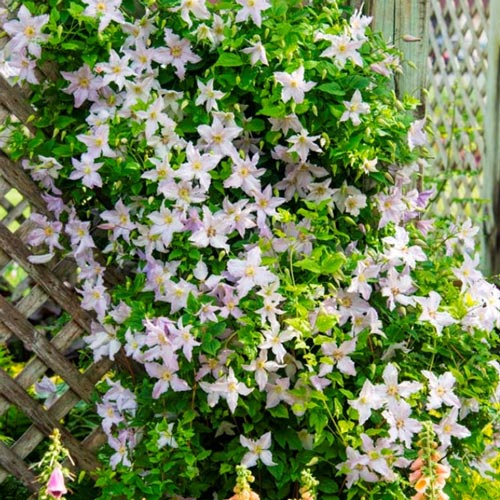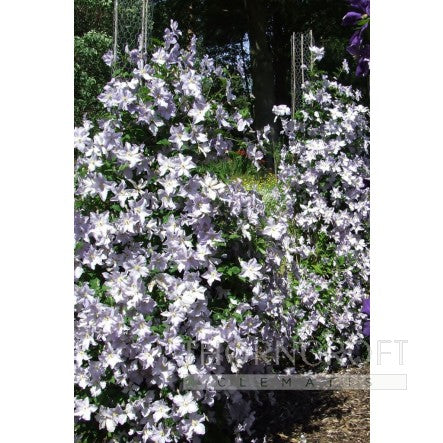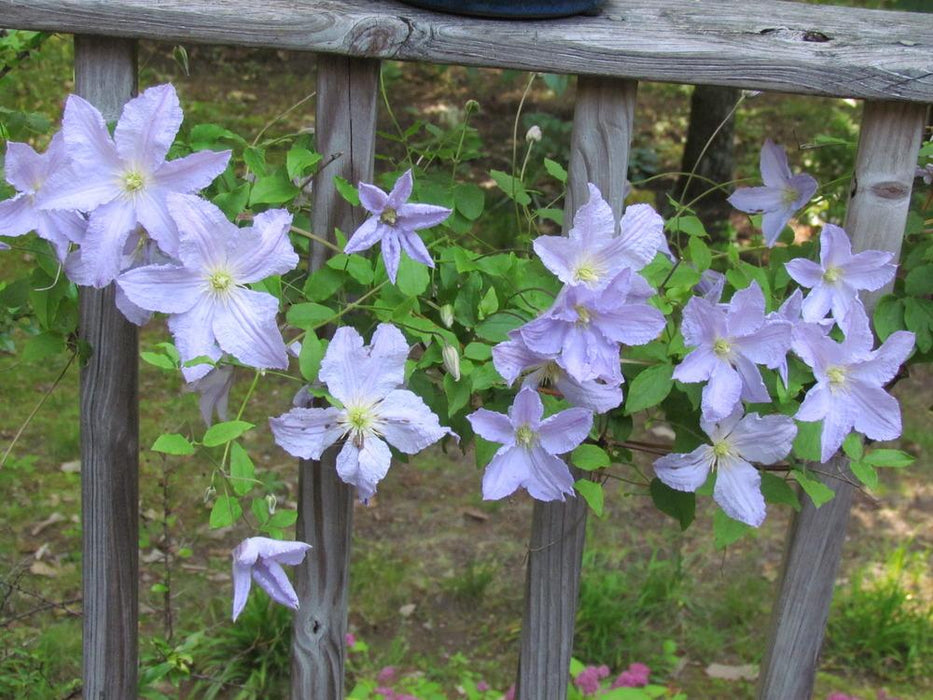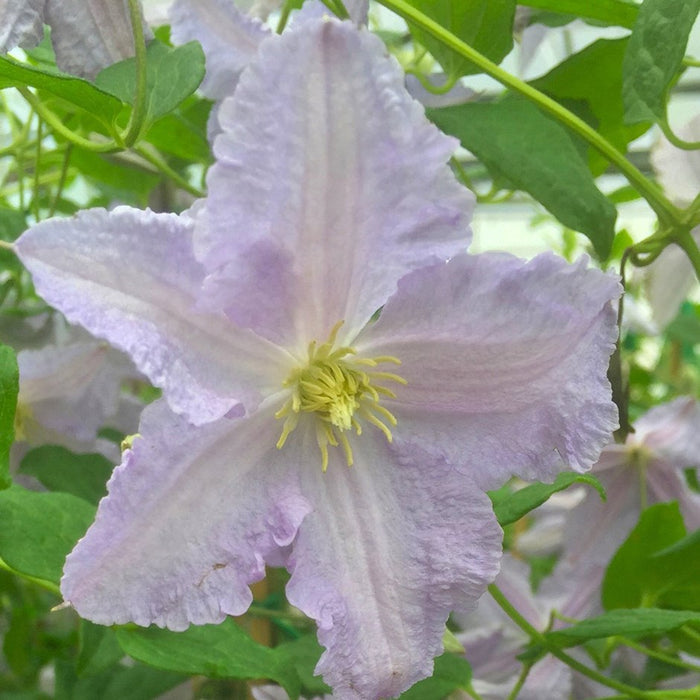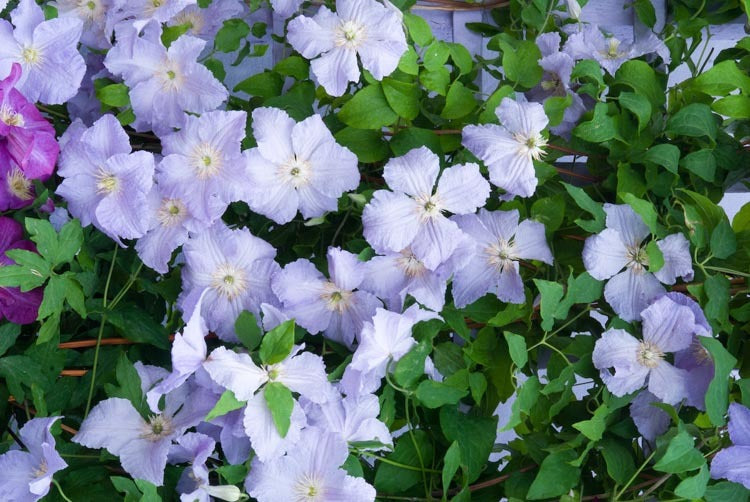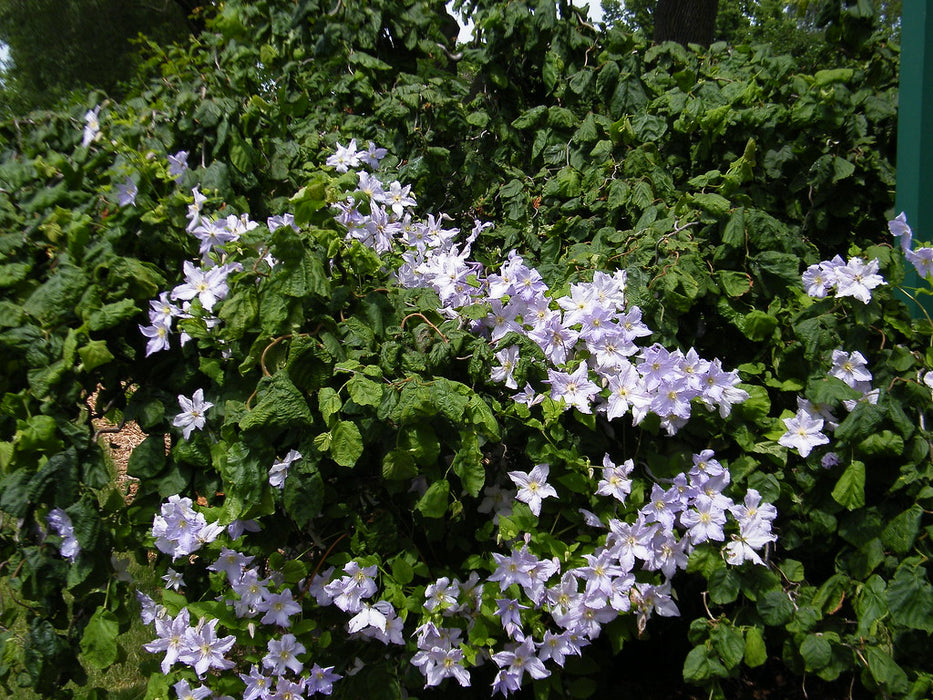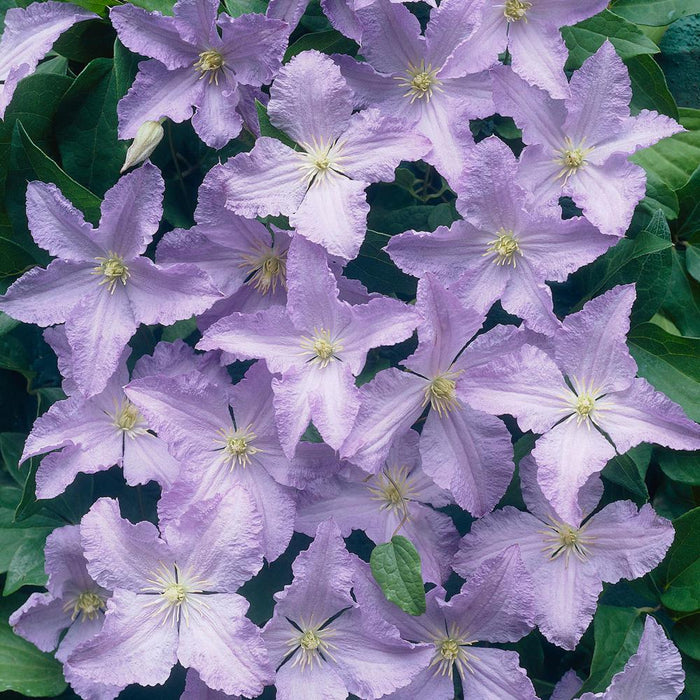
Clematis Blue Angel ( (2.5 ' POT STARTER PLANT) PERENNIAL FLOWERING VINE
Most orders are processed by the next day
Select your desired size and/or color from the available options.
Clematis can be trained to climb a wall, trellis, fence, arbor, porch, lamppost or other stationary structure. They provides good architectural height and framework for small gardens. They can also be planted to sprawl over and through shrubs, scramble over old stumps or simply as a ground cover in conjunction with other flowering perennials. Containers.
Blue Angel is not for the faint of heart; its Jack-and-the-Beanstalk growth rate can be daunting to a timid gardener. An eastern exposure is ideal for growing Blue Angel and other light colored clematis because strong sunlight will fade pastel flowers. Reserve southern and western positions for clematis in deeper shades of blue, red, and purple.
- Zones:4, 5, 6, 7, 8, 9
- Plant Height:6 to 10 feet
- Light:Full Sun to Partial Shade
- Foliage Color:Green
- Maintenance:Low
- Moisture:Medium Moisture
- Growth Rate:Moderate
- Bloom Time:Summer
- Plant Seasonal Interest:Summer Interest
- Plant Type:Vines
CLEMATIS: Always called the "Queen of Vines," nothing else makes the spectacular show of a clematis in full bloom. In almost all zones, these magnificent plants decorate mailboxes, trellises and porches with cascades of some of the most beautiful blooms in the flower kingdom, and they're not difficult to grow. There's no reason you can't add them to your landscape.
Group One: These Clematis only flower on the previous season’s growth. That means whatever growth is made before winter will be the growth that has the flowers. DON’T prune this group in winter because you will be cutting off all your flowers!
Group Two: These Clematis flower on both previous seasons growth and new growth. Prune lightly in winter to big buds making sure to cut out all weak, cluttered and dead growth. After the spring flowering, prune again to remove all the spent flowers to encourage a fresh set of flowers in summer. If the plant is sparse, prune harder to encourage branching. Feed after each pruning to encourage new growth. (This group includes most of the Large Flowered Hybrid Clematis. )
Group Three: These Clematis only flower on new growth and require hard pruning in winter to encourage new growth. Some will naturally die down to the ground. They tend to flower later in the season, around November onwards and are terrific during Summer and Autumn. This group includes the viticellas, texensis and herbaceous varietie
- Uses: Containers, Trellis, Specimen Plant
CLEMATIS: Always called the "Queen of Vines," nothing else makes the spectacular show of a clematis in full bloom. In almost all zones, these magnificent plants decorate mailboxes, trellises and porches with cascades of some of the most beautiful blooms in the flower kingdom, and they're not difficult to grow. There's no reason you can't add them to your landscape.
PLANTING CLEMATIS IS AS EASY AS 1-2-3
- 1. Loosen the soil to a depth of 12” and mix in several handfuls of compost and ¼ to ½ cup of all-purpose granular fertilizer (follow package directions).
- 2. Dig a hole deep enough for the roots, and position the clematis so the crown of the plant (where the roots meet the stem) is right at the soil line.
- 3. Cover the roots with soil, allowing the growing tips to be barely visible.
TIPS FOR PLANTING CLEMATIS
Though clematis like their “heads” in the sun, the bottom of the plant should be shaded so the roots stay relatively cool.
During the first growing season, your new clematis should be watered whenever the weather is dry. Mulching around the base of the plant will help retain moisture and keep the roots cool. Sometimes clematis need a little help holding onto a trellis or structure. You can use soft twine, waxed string or even zip-ties to attach the vines and provide extra support.
Prune clematis vines to encourage new growth, which results in more flowers.
No matter which pruning category your clematis plants fall into, flowering will diminish on all clematis vines without pruning.
Left unpruned the new growth is confined to the tops or ends of the vines and that is where your flowers will be
CARING FOR CLEMATIS AFTER THEY BLOOM
After the flowers fade, some clematis develop decorative seed heads. These can be left in place throughout the growing season. Though it's not necessary, you can also cut off the seed heads to keep the plant looking neat. Some clematis varieties bloom again in late summer or early fall. If you think your clematis could be a rebloomer, remove only the spent flower heads and avoid cutting back the foliage.
Early spring is the best time to prune a clematis. There are two approaches to pruning. Some varieties produce new growth on last year’s vines, so they should only be pruned to shape the overall plant. Others varieties die back to the ground. Since any new growth comes from the base of the plant, all of the prior year's vines can be removed. Until you get to know your clematis, it’s best to wait until the plant has sprouted new growth. That way you can see where it's coming from and prune accordingly.
Fertilize your clematis in the spring when the first leaves start to unfurl. Follow package instructions, sprinkling approximately ¼ to ½ cup of all-purpose granular fertilizer around the base of the plant.
If your clematis outgrows its space, you can control the growth by simply cutting back the entire plant to a height of 5". This can be done in fall or early spring. Stray vines may also be trimmed back any time during the growing season.
LET OUR CUSTOMER SPEAK FOR US

![[Seeds] - Caribbeangardenseed](http://caribbeangardenseed.com/cdn/shop/files/gift-card-gift-card-1_1024x1024_dfa857db-9150-4315-a362-7f0bb3fb9c47_60x28.png?v=1703978838)
